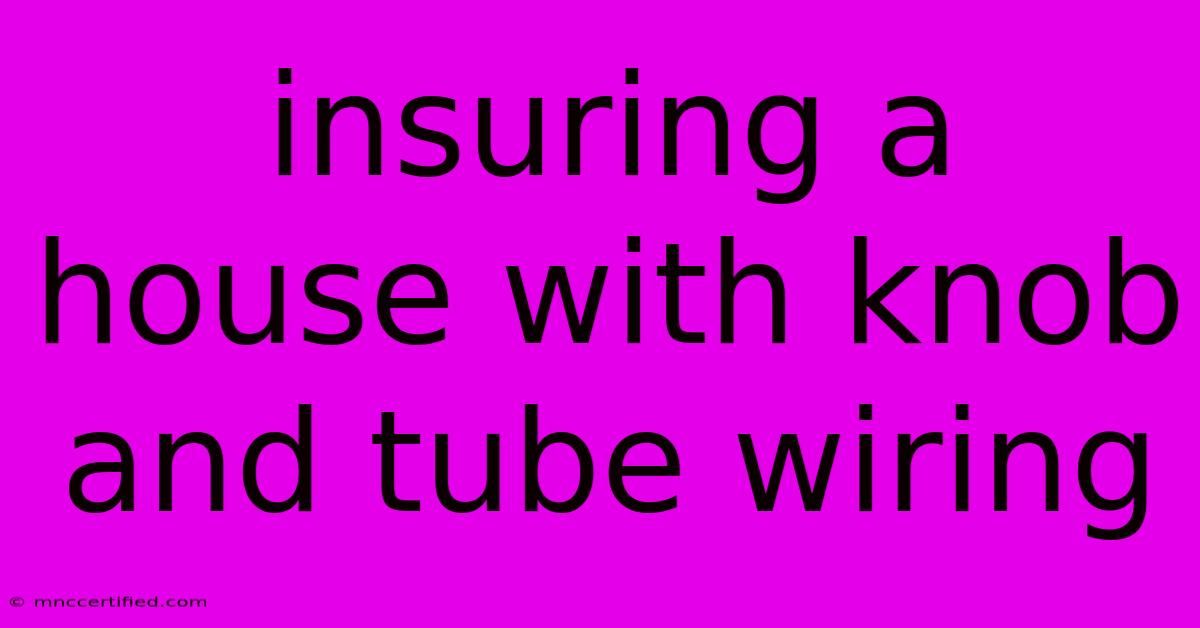Insuring A House With Knob And Tube Wiring

Table of Contents
Insuring a House with Knob and Tube Wiring: What You Need to Know
Owning a historic home with charm and character is a dream for many. But what happens when that dream home comes with an older electrical system, specifically knob and tube wiring? This type of wiring, common in homes built before the 1940s, can pose a significant fire hazard and make securing homeowner's insurance a challenge.
This article will guide you through the complexities of insuring a house with knob and tube wiring, outlining the potential risks, insurance considerations, and strategies to mitigate these challenges.
Understanding Knob and Tube Wiring: A Historical Perspective
Knob and tube wiring, as its name suggests, utilizes porcelain knobs and tubes to insulate and support electrical wires. This system was once considered state-of-the-art but has become obsolete due to safety concerns.
Here's why knob and tube wiring can be a safety concern:
- Lack of Grounding: Knob and tube wiring lacks a grounding system, which is crucial for protecting against electrical shocks and fires.
- Aging Insulation: Over time, the porcelain knobs and tubes can become brittle, cracked, or damaged, exposing bare wires and increasing the risk of short circuits.
- Increased Fire Hazard: The lack of grounding and aging insulation can lead to overheating, sparking, and potential fires.
Insurance Considerations: The Challenges of Knob and Tube Wiring
Insurance companies are understandably cautious about insuring homes with knob and tube wiring. The potential fire risk associated with this type of wiring can significantly increase the chances of claims and, consequently, insurance premiums.
Here's what you can expect:
- Higher Premiums: Expect to pay higher premiums compared to homes with modern wiring systems.
- Difficult to Insure: Some insurers may refuse to insure homes with knob and tube wiring entirely, especially if it is deemed to be in poor condition.
- Stricter Inspections: Be prepared for more rigorous inspections by insurance companies to assess the condition of your wiring.
Mitigating the Risks: Steps to Improve Your Home's Insurability
While knob and tube wiring can be a deterrent for insurance companies, several steps can mitigate the risks and increase your chances of securing affordable coverage.
Here's how to make your home more insurable:
- Professional Inspection: Have a qualified electrician conduct a comprehensive inspection of your knob and tube wiring. This inspection should identify any potential safety concerns and recommend necessary repairs or upgrades.
- Rewiring or Upgrading: Consider rewiring your home with modern, grounded electrical systems. While this can be a significant investment, it's the most effective way to eliminate the risks associated with knob and tube wiring and potentially lower your insurance premiums.
- Regular Maintenance: Regularly inspect your knob and tube wiring for any signs of damage or wear.
- Smoke Detectors and Fire Extinguishers: Ensure you have functioning smoke detectors on every level of your home and fire extinguishers readily available.
Finding the Right Insurance: Tips for Securing Coverage
Securing homeowner's insurance for a home with knob and tube wiring can be challenging but not impossible. Here are some strategies:
- Contact Specialized Insurance Companies: Seek out insurance companies that specialize in insuring historic homes or those with unique electrical systems.
- Work with an Insurance Broker: An experienced insurance broker can access a wider network of insurance carriers and help you find the best coverage options.
- Be Transparent: Be upfront with insurance companies about the presence of knob and tube wiring and any repairs or upgrades you've undertaken.
Conclusion: Balancing History and Safety
While knob and tube wiring can be a challenge for homeowners, taking proactive steps can mitigate risks and secure the necessary insurance coverage. By prioritizing safety, obtaining professional assessments, and being transparent with insurance companies, you can protect both your home and your financial well-being.

Thank you for visiting our website wich cover about Insuring A House With Knob And Tube Wiring. We hope the information provided has been useful to you. Feel free to contact us if you have any questions or need further assistance. See you next time and dont miss to bookmark.
Featured Posts
-
How Tall Is Gary Barlows Son
Nov 07, 2024
-
Wisconsin Legislature Gop Majority Citizen Voting
Nov 07, 2024
-
Will Home Insurance Cover Asbestos Removal
Nov 07, 2024
-
Being Sued For Car Accident With Insurance
Nov 07, 2024
-
Trump Victory Boosts Musks Influence
Nov 07, 2024